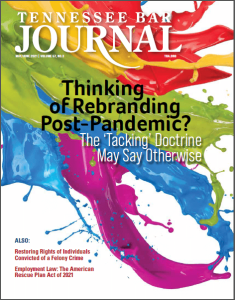CATEGORIES
Thinking of Rebranding Post-Pandemic? The ‘Tacking’ Doctrine May Say Otherwise
5.5.21
As first published in the Tennessee Bar Journal, Volume 57, No. 3 (May/June 2021) written by Patterson Shareholder Scott Douglass and Associate Dominic Rota. Used with permission of the Tennessee Bar Journal.

Tennessee Bar Journal, Volume 57, No. 3 (May/June 2021)
Many businesses are re-assessing and planning for an economic future after the disruption of the COVID-19 pandemic. One pathway to growth is corporate rebranding of a company name, logo, or design. Businesses looking to bridge historic brand recognition with a modern update should explore the legal doctrine of “tacking”. “Tacking” is a trademark law concept that allows owners of a current mark (word, phrase, symbol, or design) to expand intellectual property protection onto a new mark. A review of court decisions, however, reveals that “tacking” is no easy feat; consequently, businesses should ensure that the rebrand adheres to the requisite legal niceties that have developed as courts kept pace with changing trademarks and consumer tastes.
The economic slowdown has led companies to reconsider marketing plans and changes in consumer habits when the economy fully reopens, such as the emergence of care culture and the passion economy. Audi, the automobile manufacturer, tweaked its known interlocking four-ring design, by separating the four rings apart from one another and encouraging customers to “keep distance.” Though Nike did not alter the famed swoosh, it launched a social media campaign encouraging consumers to “play inside, play for the world.” Although some entities have launched campaigns directed to community welfare, others have rebranded without regard to the COVID-19 pandemic. Adobe rolled out extensive changes to its brand identity, establishing a cohesive color gradient for its product line. Other global corporations have performed substantive rebrands to their logos, such as GoDaddy, Microsoft Edge, Nissan, BMW, and Google Maps.
Whether looking to shift brand identity to address the global marketplace amidst the pandemic or to complete an anticipated corporate redesign, businesses should account for the legal ramifications of altering their consumer-facing brands. Rebranding of slogans, designs or other source-identifying images implicates the legal doctrine of “tacking”: a trademark law concept that seeks to bridge the new with the old.
Trademark Law: Primer
A trademark is a word, phrase, symbol or design that distinguishes the source of the goods or services of one party from those of its competitors. A trademark distills consumers’ brand perception into a marketable, reproducible and valuable tool to gain a competitive edge. Trademark rights derive from use in commerce in connection with the applicable goods and services. Without use, a business has no rights in the mark. And the longer and more distinctive the use, the stronger the mark with relevant consumers.
Superior trademark rights are determined by the date of the mark’s “first use in commerce.”1 The party who first uses a mark in commerce has priority over other uses. Typically, the older a mark, the stronger it is because more consumers recognize the mark as signifying a single source for goods or services over the course of time. But, as consumer preferences evolve over time, so do marks. Courts therefore permit mark owners to “clothe a new mark with the priority position of an older” through “tacking.”2 This modification and reclothing of an old mark is available to any mark owner, subject to certain conditions and restrictions.
To effectively tack one mark (i.e., the subsequent mark) onto another (i.e., the original mark), the original and subsequent marks must be “legal equivalents.”3 Marks are considered “legal equivalents” where the two marks “create the same, continuing commercial impression” so that the relevant consumers “consider both as the same mark.”4 A company can establish the same “continuing, commercial impression” through a subsequent mark, so long as the subsequent mark does not “materially differ from or alter the character of” the original mark.5 This inquiry focuses chiefly on “the visual and aural impact [of the marks,] taken as a whole.”6 A mark owner “cannot expand its rights in an earlier mark by tacking it onto a later mark with a broader commercial impression.”7
Tacking a rebrand onto an older version of a company’s trademark sounds like a no-brainer, but courts only allow mark owners to tack to older marks “sparingly” and in “rare instances.”8 Consequently, companies should consider the extent of the rebrand because a perceived “update” may in fact be a wholesale change in the eyes of the law.
Where Courts Have Rejected the Application of the ‘Tacking’ Doctrine
Federal courts have been reluctant to allow tacking, even where the successor-mark is a near-equivalent to the former mark. In the three cases discussed below, courts denied the application of tacking, even though the subsequent marks were highly similar and related to the original mark.
In American Paging Inc. v. American Mobilphone Inc.,9 the new mark featuring the phrase AMERICAN MOBILE PHONE PAGING and a design were not allowed to tack on to AMERICAN MOBILE PHONE because the marks were distinguishable when spoken, even though the marks were barely visually distinguishable.10
![]()
The Trademark Trial and Appeal Board (TTAB) noted that the original mark and the subsequent mark are both “dominated by the word AMERICAN and the same star and double bar design,” and “[t]he words MOBILPHONE and MOBILPHONE PAGING are, of course, depicted in subordinate fashion.”11 Nevertheless, the court found the marks distinguishable when spoken. And “in terms of connotation, the court found the AMERICAN MOBILPHONE PAGING mark more informative than and hence legally different from the AMERICAN MOBILPHONE mark.”12
In One Industries LLC v. Jim O’Neal Distributing Inc., a “Rounded O’ mark” was not allowed to tack on to an “Angular O’ mark.”13
![]()
The Ninth Circuit explained that tacking was “exceedingly strict.” It then addressed numerous, miniscule, subtle differences between these two marks that added up, in sum, to dissimilar marks: (i) the apostrophe in the “Round O’ mark [] is entirely separated from the O,” whereas the “Angular O’ mark’s apostrophe is connected to the main image and looks like a triangle”; (ii)
“[t]he lower and upper horizontal lines on the Round O’ mark are thinner than the corresponding lines on the Angular O’ mark”; and (iii) the “Rounded O’ mark is boxy,” unlike the “Angular O’ mark [which] looks like the outline of a lemon.”14
Courts have also denied a mark owner’s desire to acronymize its original mark. In George & Co. LLC v. Imagination Entertainment Ltd., a party sought to tack protection of the subsequent mark “LCR” onto the original mark “LEFT CENTER RIGHT.” The mark owner argued that an acronym is the legal equivalent of a fully articulated and spelled term or word. The Fourth Circuit disagreed, finding that the marks were not confusingly similar.15 Its opinion pointed to cases where a shorter mark was found to not constitute the “legal equivalent” of the longer mark. In Data Concepts Inc. v. Digital Consulting Inc.,16 the Sixth Circuit held that the marks “DCI” and “dci” were too dissimilar to support tacking. And, in Van Dyne-Crotty Inc. v. Wear-Guard Corp.,17 the Federal Circuit found that the subsequent, shorter mark “CLOTHES THAT WORK” was not legally equivalent to the original, longer mark “CLOTHES THAT WORK FOR THE WORK YOU DO.” The takeaway is that, even where enterprises consider rebranding the original mark to merely entail the shortening of the original phrase (or acronymization of the original term), courts remain reluctant to extend protection through tacking.
Other courts have focused on “customer confusion” with a competitor’s mark. In Ancestry.com Operations Inc. v. DNA Diagnostics Ctr. Inc., a federal district court compared the original mark “ANCESTRY” with the subsequent mark “ANCESTRYDNA.” In rejecting tacking, the court found there was no customer confusion between the mark “ANCESTRY” and a competitor’s mark “ANCESTRYBYDNA” until the mark-owner’s introduction of “ANCESTRYDNA.” The court emphasized that mark-owners cannot develop marks similar to competitors and hope to retroactively expand the legal reach of the original mark.
Where Courts Have Applied the Doctrine of ‘Tacking’
There is hope. Some courts have provided a blueprint for permissible tacking. In Paris Glove of Canada Ltd. v. SBC/Sporto Corp., the TTAB found AQUA STOP, in stylized and rectangular form, to be the legal equivalent to AQUA STOP, in semicircular form.
![]()
Although not identical, the marks gave the same commercial impression, paying special attention to the literal term “AQUA STOP,” rather than the geometrical configuration of the words.18
In another example, the Southern District of Ohio allowed a mark owner to chain the legal impression of the original mark “ServiceMASTER” with the subsequent mark “ServiceMASTER Clean.”19 The court noted that the minor alteration did not change the fundamental commercial impression of the original mark, which reflected a core value of the corporation.20
Conclusion
While courts make it difficult to extend protection of original marks onto subsequent marks, tacking permits marks to be modernized to benefit from their historical appearance while accounting for changing consumer tastes — or rebranding in a post-pandemic world. With planning and counsel, companies can avoid throwing away their substantial consumer goodwill while maximizing the benefit of a brand refresh.

SCOTT DOUGLASS is a shareholder at Patterson Intellectual Property Law. He advises clients on brand protection and enforcement issues and litigates trademark and copyright disputes. He can be contacted at smd@iplawgroup.com.
 DOMINIC ROTA is a registered patent attorney and associate at Patterson Intellectual Property Law. He prosecutes, enforces, and litigates patent and trademark issues, and guides clients to compliance with information security and data privacy standards. He can be contacted at dar@iplawgroup.com
DOMINIC ROTA is a registered patent attorney and associate at Patterson Intellectual Property Law. He prosecutes, enforces, and litigates patent and trademark issues, and guides clients to compliance with information security and data privacy standards. He can be contacted at dar@iplawgroup.com
NOTES:
1. See 15 U.S.C. § 1051(a)(2).
2. Hana Fin., Inc. v. Hana Bank, 574 U.S. 418, 419 (2015).
3. Hana Fin., Inc. v. Hana Bank, 574 U.S. 418, 422 (2015).
4. Hana Fin., Inc. v. Hana Bank, 574 U.S. 418, 422 (2015).
5. Jack Wolfskin Ausrustung Fur Draussen GmbH & Co. KGAA v. New Millennium Sports, S.L.U., 797 F.3d 1363, 1368 (Fed. Cir. 2015).
6. 1 Gilson on Trademarks § 3.04 (2019).
7. See, e.g., Van Dyne-Crotty, Inc. v. Wear-Guard Corp., 926 F.2d 1156 (Fed. Cir. 1991); see also, e.g., Brookfield Communications, Inc. v. West Coast Entertainment Corp., 174 F.3d 1036 (9th Cir. 1999).
8. 1 Gilson on Trademarks § 3.04 (2019)
9. Am. Paging Inc. v. Am. Mobilphone Inc., 13 U.S.P.Q.2D (BNA) 2036, 1989 WL 274416, at *4 (Trademark Trial & App. Bd. Nov. 15, 1989).
10. Am. Paging Inc. v. Am. Mobilphone Inc., 13 U.S.P.Q.2D (BNA) 2036, 1989 WL 274416, at *4 (Trademark Trial & App. Bd. Nov. 15, 1989).
11. Am. Paging Inc. v. Am. Mobilphone Inc., 13 U.S.P.Q.2D (BNA) 2036, 1989 WL 274416, at *4 (Trademark Trial & App. Bd. Nov. 15, 1989).
12. Am. Paging Inc. v. Am. Mobilphone Inc., 13 U.S.P.Q.2D (BNA) 2036, 1989 WL 274416, at *4 (Trademark Trial & App. Bd. Nov. 15, 1989).
13. One Industries LLC v. Jim O’Neal Distributing Inc., 578 F.3d 1154, 1161, 92 U.S.P.Q.2d 1065, 74 Fed. R. Serv. 3d 778 (9th Cir. 2009).
14. One Indus. LLC v. Jim O’Neal Distrib. Inc., 578 F.3d 1154, 1161 (9th Cir. 2009).
15. George & Co. LLC v. Imagination Entm’t Ltd., 575 F.3d 383, 402 (4th Cir. 2009).
16. 150 F.3d 620, 623–24 (6th Cir. 1998).
17. 926 F.2d 1156 (Fed. Cir. 1991).
18. Paris Glove of Canada Ltd. v. SBC/Sporto Corp., 84 U.S.P.Q.2d 1856, 2007 WL 2422997, at *7 (T.T.A.B. 2007).
19. D & J Master Clean Inc. v. Servicemaster Co., 181 F. Supp. 2d 821, 825 (S.D. Ohio 2002).
20. D & J Master Clean Inc. v. Servicemaster Co., 181 F. Supp. 2d 821, 825 (S.D. Ohio 2002).
